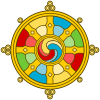Langdarma: Difference between revisions
added Tibetan Buddhism box |
m Add zh |
||
| Line 29: | Line 29: | ||
[[fr:Langdarma]] |
[[fr:Langdarma]] |
||
[[ru:Ландарма]] |
[[ru:Ландарма]] |
||
[[zh:朗达玛]] |
|||
Revision as of 05:34, 5 March 2008
| Langdarma | |||||||||
| Tibetan name | |||||||||
|---|---|---|---|---|---|---|---|---|---|
| Tibetan | གླང་དར་མ་།་འུ་དུམ་བཙན་པོ | ||||||||
| |||||||||
| Chinese name | |||||||||
| Traditional Chinese | 朗達瑪 | ||||||||
| Simplified Chinese | 朗达玛 | ||||||||
| |||||||||
| Part of a series on |
| Tibetan Buddhism |
|---|
 |
Langdarma was the last Tibetan emperor, who reigned from 838-841 CE.
By tradition Langdarma is held to be have been anti-Buddhist and a follower of the Bön religion. He is attributed with the assassination of his brother, King Ralpacan, in 838 CE and of general persecution of Buddhists. The Anti-Buddhism portrayal of this emperor has been questioned by several historians, most prominently Yamaguchi Zuiho.
Langdarma's reign was plagued by external troubles. The Uyghur state to the North collapsed under pressure from the Kyrgyz in 840, and many displaced persons fled to Tibet.
According to one source he only reigned for a year and a half, while others give six or thirteen years.[1] Langdarma himself was assassinated, apparently by a Buddhist hermit, in 842.[2]
Langdarma is said to have had two sons, Yumten, by his first wife, and Ösung by his second wife. They apparently competed for power, the former ruling over the central kingdom of Ü, and the other of over the 'left wing' - probably the eastern territories.[3]
Footnotes
- ^ Stein, R. A. 1972. Tibetan Civilization. Stanford University Press, pp. 70-71. ISBN 0-8047-0806-1 (cloth); ISBN 0-8047-0901-7 (pbk).
- ^ Beckwith, Christopher I. 1987. The Tibetan Empire in Central Asia: A History of the Struggle for Great Power among Tibetans, Turks, Arabs, and Chinese during the Early Middle Ages. Princeton University Press, pp. 168-169. ISBN 0-691-02469-3.
- ^ Stein, R. A. 1972. Tibetan Civilization. Stanford University Press, pp. 70-71. ISBN 0-8047-0806-1 (cloth); ISBN 0-8047-0901-7 (pbk).
External links
- http://www.haiweitrails.com/timeline_tibet.htm (accessed: Sunday January 14, 2007)
